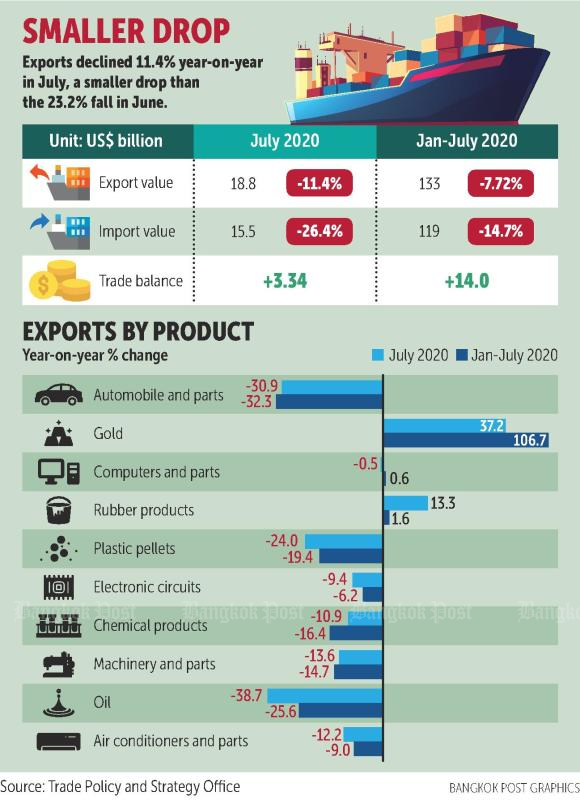Thailand: July figures offer gleam of hope
Exports showed signs of recovery, with July figures registering a smaller drop of 11.4% year-on-year after a 23.2% fall in June, which was the weakest pace since July 2009.
Pimchanok Vonkorpon, director-general of the Trade Policy and Strategy Office under the Commerce Ministry, said the strong expansion came from food products (cassava products; palm oil; canned tuna; fresh, chilled and frozen chicken; and pet food) as well as work-from-home and Covid-19-related products (furniture and parts; ovens; microwaves; refrigerators and freezers; washing machines; and rubber gloves) that helped curb the export slide.
Customs-cleared exports fetched US$18.8 billion in July, with imports dropping 26.4% to $15.5 billion, resulting in a trade surplus of $3.34 billion, said Ms Pimchanok.
Shipments of agricultural and agro-industrial products fell 10.9% year-on-year in July to $3.08 billion led by rubber (-54.1%), sugar (-42.4%), rice (-16.8%) and chilled and frozen shrimp (-15.9%).
Exports of industrial products also declined, down 10.3% in the same month to $15.2 billion, weighed down by oil-related products (-24.9%), automobiles and parts (-30.9%), radio broadcast receivers, TV receivers and parts (-23.3%), and iron and steel products (-22.6%).
For the first seven months, exports fell 7.72% from the same period last year to $133 billion, while imports dropped 14.7% to $119 billion, resulting in a trade surplus of $14 billion.
Export value to most major trading partners contracted at a slower rate than the previous month, suggesting exports are likely to improve gradually after several countries succeeded in controlling their Covid-19 outbreaks and eased lockdown measures, along with government stimulus measures to accelerate recovery.
Shipments to the US expanded by 17.8% year-on-year in July, she said.
“Exports passed a low point during May to June. Performance from now on is likely to see a gradual recovery,” said Ms Pimchanok.
“There are potential products that can support export prospects such as food items, as Thailand has the production capability and a considerable advantage in food quality and safety standards. There will be demand for new types of products in response to changing consumer behaviour during Covid-19.”
However, she admitted any export recovery remains nascent as so much remains unknown during the outbreak and global economic slowdown, such as a possible second wave and lockdown measures, higher trade restrictions, baht appreciation as well as depressed oil prices in the global market.
Ms Pimchanok said the ministry still expects exports to fall by 8%-9% this year to $224-227 billion.
Ghanyapad Tantipipatpong, chairwoman of the Thai National Shippers’ Council, said July export figures were better than expected, with an upward trend anticipated for the remaining months this year.
Exports may shrink less than 10% this year, she said.
Source: https://www.bangkokpost.com/business/1973907/july-figures-offer-gleam-of-hope


 Thailand
Thailand




